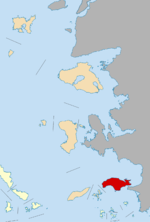The birthplace of the genius of Samos, Pythagoras
Samos is a Greek island in the eastern Aegean Sea, south of Chios, north of Patmos and the Dodecanese, and off the coast of Asia Minor, from which it is separated by the 1.6 kilometres (0.99 mi)-wide Mycale Strait. It is also a separate regional unit of the North Aegean region, and the only municipality of the regional unit.
In ancient times Samos was a particularly rich and powerful city-state. It is home to Pythagoreion and the Heraion of Samos, a UNESCO World Heritage Site that includes the Eupalinian aqueduct, a marvel of ancient engineering. Samos is the birthplace of the Greek philosopher and mathematician Pythagoras, after whom the Pythagorean theorem is named, the philosopher Epicurus, and the astronomer Aristarchus of Samos, the first known individual to propose that the Earth revolves around the sun. Samian wine was well known in antiquity, and is still produced on the island.
The island was an autonomous principality from 1835 until it joined Greece in 1912.
Pythagoras of Samos b. about 570 – d. about 495 BC)[ was an Ionian Greek philosopher, mathematician, and founder of the religious movement called Pythagoreanism. Most of the information about Pythagoras was written down centuries after he lived, so very little reliable information is known about him. He was born on the island of Samos, and might have travelled widely in his youth, visiting Egypt and other places seeking knowledge. Around 530 BC, he moved to Croton, a Greek colony in southern Italy, and there set up a religious sect. His followers pursued the religious rites and practices developed by Pythagoras, and studied his philosophical theories. The society took an active role in the politics of Croton, but this eventually led to their downfall. The Pythagorean meeting-places were burned, and Pythagoras was forced to flee the city. He is said to have ended his days in Metapontum.
Pythagoras made influential contributions to philosophy and religious teaching in the late 6th century BC. He is often revered as a great mathematician, mystic and scientist, but he is best known for the Pythagorean theorem which bears his name. However, because legend and obfuscation cloud his work even more than that of the other pre-Socratic philosophers, one can give only a tentative account of his teachings, and some have questioned whether he contributed much to mathematics and natural philosophy. Many of the accomplishments credited to Pythagoras may actually have been accomplishments of his colleagues and successors. Whether or not his disciples believed that everything was related to mathematics and that numbers were the ultimate reality is unknown. It was said that he was the first man to call himself a philosopher, or lover of wisdom, and Pythagorean ideas exercised a marked influence on Plato, and through him, all of Western philosophy.
mounted atop it was an ornamental bronze sextant
A sextant is an instrument used to measure the angle between any two visible objects. Its primary use is to determine the angle between a celestial object and the horizon which is known as the object's altitude. Making this measurement is known as sighting the object, shooting the object, or taking a sight and it is an essential part of celestial navigation. The angle, and the time when it was measured, can be used to calculate a position line on a nautical or aeronautical chart. Common uses of the sextant include sighting the sun at solar noon and sighting Polaris at night, to find one's latitude (in northern latitudes). A sextant can also be held horizontally to measure the angle between any two landmarks which allows for calculation of a position on a chart. A sextant can also be used to measure the Lunar distance between the moon and another celestial object (e.g., star, planet) in order to determine Greenwich time which is important because it can then be used to determine the longitude.It's comically large telescope resembled the barrel of a blunderbuss.
The scale of a sextant has a length of ⅙ of a turn (60°); hence the sextant's name (sextāns, -antis is the Latin word for "one sixth"). An octant is a similar device with a shorter scale (⅛ turn, or 45°), whereas a quintant (⅕ turn, or 72°) and a quadrant (¼ turn, or 90°) have longer scales.
Sir Isaac Newton (1643–1727) invented the principle of the doubly reflecting navigation instrument (a reflecting quadrant—see Octant (instrument)), but never published it. Two men independently developed the octant around 1730: John Hadley (1682–1744), an English mathematician, and Thomas Godfrey (1704–1749), a glazier in Philadelphia. John Bird made the first sextant in 1757. The octant and later the sextant, replaced the Davis quadrant as the main instrument for navigation.
The blunderbuss is a muzzle-loading firearm with a short, large caliber barrel, which is flared at the muzzle and frequently throughout the entire bore, and used with shot and other projectiles of relevant quantity and/or caliber. The blunderbuss could be considered to be an early form of shotgun or muzzleloader, which was often adapted to military and defensive use.It was effective at short ranges, but lacked accuracy for targets at long range. The term dragon was used to describe a blunderbuss in handgun form, and it is from this that the term dragoon evolved



No comments:
Post a Comment